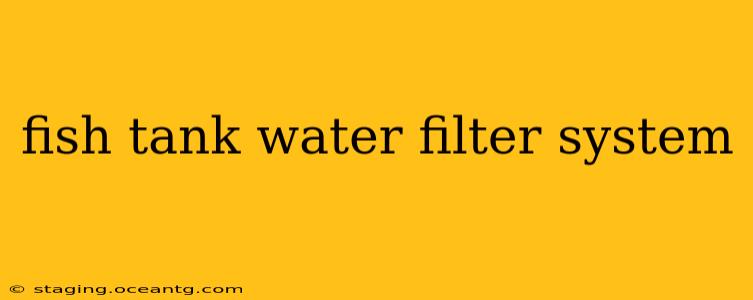Maintaining a healthy and thriving aquatic environment requires a robust fish tank water filter system. Choosing the right filter is crucial for the well-being of your fish and the overall cleanliness of your aquarium. This guide delves into the intricacies of fish tank water filtration, helping you select the perfect system for your needs.
What are the Different Types of Fish Tank Water Filter Systems?
Several types of fish tank water filter systems exist, each with its own advantages and disadvantages. Understanding these differences is key to making an informed decision. The most common types include:
-
Hang-on-back (HOB) filters: These are popular choices for smaller tanks due to their ease of installation and affordability. They hang on the back of the tank, utilizing the tank's water for filtration.
-
Undergravel filters (UGF): These filters work by drawing water through a gravel bed, utilizing the gravel as a biological filter media. They are less common now, often seen as less efficient than other options.
-
Canister filters: Ideal for larger tanks, canister filters are external, powerful systems that provide superior filtration. They offer greater media capacity and flexibility in choosing filter media.
-
Internal filters: These compact filters are submerged within the tank, providing a good balance between filtration and ease of use. They're suitable for smaller to medium-sized tanks.
-
Sump filters: These sophisticated systems are usually used in larger, more advanced aquariums. A sump is a separate tank that houses the filter components, allowing for a cleaner main tank display.
How Does a Fish Tank Water Filter System Work?
A typical fish tank water filter system works through a multi-stage process:
-
Mechanical Filtration: This stage removes larger debris such as fish waste, uneaten food, and plant matter. This is often achieved using filter pads or sponges.
-
Biological Filtration: This is the crucial stage where beneficial bacteria colonies break down harmful ammonia and nitrite into less toxic nitrate. This process requires specialized filter media such as bio-balls or ceramic rings.
-
Chemical Filtration: This stage involves the use of activated carbon or other media to remove dissolved impurities, odors, and discoloration from the water.
What are the Best Filter Media for my Fish Tank?
Choosing the right filter media depends on your specific needs and the type of filter you're using. Common filter media includes:
- Filter pads/sponges: For mechanical filtration.
- Bio-balls/ceramic rings: For biological filtration.
- Activated carbon: For chemical filtration.
- Zeolites: For ammonia and phosphate removal.
How Often Should I Clean or Replace my Fish Tank Filter Media?
Cleaning and replacing filter media are crucial for maintaining a healthy aquarium. The frequency depends on the type of media and tank size. Generally:
- Filter pads/sponges: These should be rinsed in old tank water (never tap water) every few weeks. Replace them every few months.
- Bio-balls/ceramic rings: These should be cleaned less frequently, perhaps every few months. Avoid completely replacing them at once, to maintain beneficial bacteria colonies.
- Activated carbon: This should be replaced every few weeks or months, as it becomes saturated.
How Do I Choose the Right Filter for My Tank Size?
Choosing the right filter size is crucial for effective water filtration. Most manufacturers provide guidelines based on tank gallons. Always choose a filter that's rated for a capacity slightly larger than your tank. Over-filtration is preferable to under-filtration.
What is the Importance of Regular Water Changes in Fish Keeping?
Even with the best filtration system, regular water changes are essential. They help remove excess nutrients, maintain water quality, and prevent the buildup of harmful substances. Aim for partial water changes (around 25%) weekly or bi-weekly.
How Often Should I Replace my Fish Tank Filter?
The lifespan of a fish tank filter varies depending on the brand and usage. Generally, you should expect to replace the entire filter unit every 1-2 years, or sooner if it becomes damaged or significantly less effective. Components such as impellers and pumps might need replacing before the entire unit.
This comprehensive guide offers a solid foundation for understanding fish tank water filter systems. Remember, a healthy aquarium relies on a combination of proper filtration, regular maintenance, and responsible fish keeping practices.
